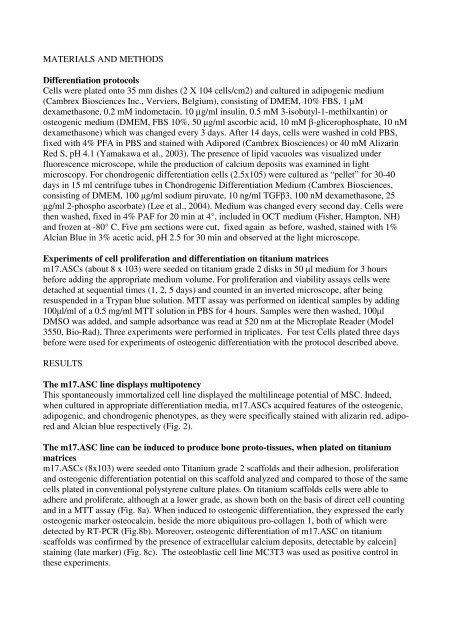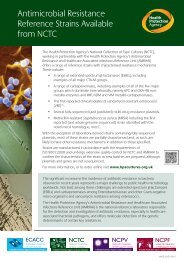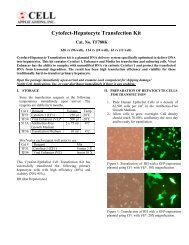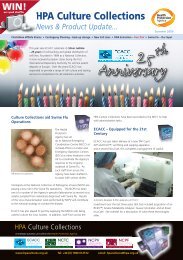11112201_m17.ASC_Differentiation protocols
11112201_m17.ASC_Differentiation protocols
11112201_m17.ASC_Differentiation protocols
Create successful ePaper yourself
Turn your PDF publications into a flip-book with our unique Google optimized e-Paper software.
MATERIALS AND METHODS<br />
<strong>Differentiation</strong> <strong>protocols</strong><br />
Cells were plated onto 35 mm dishes (2 X 104 cells/cm2) and cultured in adipogenic medium<br />
(Cambrex Biosciences Inc., Verviers, Belgium), consisting of DMEM, 10% FBS, 1 µM<br />
dexamethasone, 0.2 mM indometacin, 10 µg/ml insulin, 0.5 mM 3-isobutyl-1-methilxantin) or<br />
osteogenic medium (DMEM, FBS 10%, 50 µg/ml ascorbic acid, 10 mM β-glicerophosphate, 10 nM<br />
dexamethasone) which was changed every 3 days. After 14 days, cells were washed in cold PBS,<br />
fixed with 4% PFA in PBS and stained with Adipored (Cambrex Biosciences) or 40 mM Alizarin<br />
Red S, pH 4.1 (Yamakawa et al., 2003). The presence of lipid vacuoles was visualized under<br />
fluorescence microscope, while the production of calcium deposits was examined in light<br />
microscopy. For chondrogenic differentiation cells (2.5x105) were cultured as “pellet” for 30-40<br />
days in 15 ml centrifuge tubes in Chondrogenic <strong>Differentiation</strong> Medium (Cambrex Biosciences,<br />
consisting of DMEM, 100 µg/ml sodium piruvate, 10 ng/ml TGFβ3, 100 nM dexamethasone, 25<br />
µg/ml 2-phospho ascorbate) (Lee et al., 2004). Medium was changed every second day. Cells were<br />
then washed, fixed in 4% PAF for 20 min at 4°, included in OCT medium (Fisher, Hampton, NH)<br />
and frozen at -80° C. Five µm sections were cut, fixed again as before, washed, stained with 1%<br />
Alcian Blue in 3% acetic acid, pH 2.5 for 30 min and observed at the light microscope.<br />
Experiments of cell proliferation and differentiation on titanium matrices<br />
<strong>m17.ASC</strong>s (about 8 x 103) were seeded on titanium grade 2 disks in 50 µl medium for 3 hours<br />
before adding the appropriate medium volume. For proliferation and viability assays cells were<br />
detached at sequential times (1, 2, 5 days) and counted in an inverted microscope, after being<br />
resuspended in a Trypan blue solution. MTT assay was performed on identical samples by adding<br />
100µl/ml of a 0.5 mg/ml MTT solution in PBS for 4 hours. Samples were then washed, 100µl<br />
DMSO was added, and sample adsorbance was read at 520 nm at the Microplate Reader (Model<br />
3550, Bio-Rad). Three experiments were performed in triplicates. For test Cells plated three days<br />
before were used for experiments of osteogenic differentiation with the protocol described above.<br />
RESULTS<br />
The <strong>m17.ASC</strong> line displays multipotency<br />
This spontaneously immortalized cell line displayed the multilineage potential of MSC. Indeed,<br />
when cultured in appropriate differentiation media, <strong>m17.ASC</strong>s acquired features of the osteogenic,<br />
adipogenic, and chondrogenic phenotypes, as they were specifically stained with alizarin red, adipored<br />
and Alcian blue respectively (Fig. 2).<br />
The <strong>m17.ASC</strong> line can be induced to produce bone proto-tissues, when plated on titanium<br />
matrices<br />
<strong>m17.ASC</strong>s (8x103) were seeded onto Titanium grade 2 scaffolds and their adhesion, proliferation<br />
and osteogenic differentiation potential on this scaffold analyzed and compared to those of the same<br />
cells plated in conventional polystyrene culture plates. On titanium scaffolds cells were able to<br />
adhere and proliferate, although at a lower grade, as shown both on the basis of direct cell counting<br />
and in a MTT assay (Fig. 8a). When induced to osteogenic differentiation, they expressed the early<br />
osteogenic marker osteocalcin, beside the more ubiquitous pro-collagen 1, both of which were<br />
detected by RT-PCR (Fig.8b). Moreover, osteogenic differentiation of <strong>m17.ASC</strong> on titanium<br />
scaffolds was confirmed by the presence of extracellular calcium deposits, detectable by calcein]<br />
staining (late marker) (Fig. 8c). The osteoblastic cell line MC3T3 was used as positive control in<br />
these experiments.







